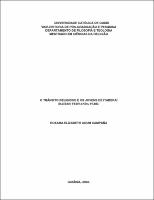| Compartilhamento |


|
Use este identificador para citar ou linkar para este item:
http://tede2.pucgoias.edu.br:8080/handle/tede/912Registro completo de metadados
| Campo DC | Valor | Idioma |
|---|---|---|
| dc.creator | Campaña, Roxana Elizabeth Adum | - |
| dc.creator.Lattes | http://buscatextual.cnpq.br/buscatextual/visualizacv.do?id=K4755584E5 | por |
| dc.contributor.advisor1 | Cezne, Irene Dias de Oliveira | - |
| dc.contributor.advisor1Lattes | http://buscatextual.cnpq.br/buscatextual/visualizacv.do?id=K4708753A2 | por |
| dc.contributor.referee1 | Silva, Valmor da | - |
| dc.contributor.referee1Lattes | http://buscatextual.cnpq.br/buscatextual/visualizacv.do?id=K4708687A0 | por |
| dc.contributor.referee2 | Pessoa, Jadir de Morais | - |
| dc.contributor.referee2Lattes | http://lattes.cnpq.br/7640102236711284 | por |
| dc.date.accessioned | 2016-07-27T13:48:47Z | - |
| dc.date.available | 2006-11-16 | - |
| dc.date.issued | 2002-12-31 | - |
| dc.identifier.citation | CAMPAÑA, Roxana Elizabeth Adum. O trânsito religioso e os jovens de Itaberaí (bairro Fernanda Park). 2002. 121 f. Dissertação (Mestrado em Ciências da Religião) -- Departamento de Filosofia e Teologia, Universidade Católica de Goiás, Goiânia, 2002. | por |
| dc.identifier.uri | http://localhost:8080/tede/handle/tede/912 | - |
| dc.description.resumo | No contexto da pós-modernidade, manifestam-se crenças e práticas rituais estilhaçadas que demonstram a existência de múltiplas vias de acesso ao sagrado. A interação entre indivíduo e religião apresenta-se marcada por uma conduta individual mais flexível e fluída, sob a lógica da relativização de fronteiras entre os sistemas religiosos disponíveis. É possível, então, organizar uma classificação da experiência religiosa contemporânea, destacando pelo menos três formas de manifestação dessa experiência: a privatização do sagrado, o trânsito religioso e o deslocamento do sagrado. Hoje, a mudança religiosa existe como alternativa e pode ocorrer mais de uma vez na trajetória de vida desses sujeitos. Peregrinar entre diferentes opções religiosas é uma atitude plausível tanto para jovens católicos como não católicos. Observamos que seja assumindo uma construção privada de seu cosmo sagrado , seja peregrinando entre diferentes opções religiosas, ou ainda conjugando tradições religiosas e seculares, os elementos comuns que perpassam a experiência religiosa contemporânea tem as dimensões: emocional, holísta e terapêutica, manifestando-se diferentemente de acordo com sujeito e contextos sócio-culturais. Por sua vez, a análise dessas dimensões abre a oportunidade para repensar, de um lado, transformações no âmbito das instituições religiosas e, de outro, o processo de formação das identidades social e individual na cultura brasileira, que possibilita também repensar os novos conceitos que a sociedade contemporânea nos propõe, que com a influência da secularização mudaram, não mais para uma perda da religião e sim para um surgimento revitalizado da mesma. | por |
| dc.description.abstract | In the post-modern context, splinter beliefs and ritual practices appear which demonstrate the existence of various ways to reach the sacred. The interaction between the individual and religion presents itself marked with a more flexible and fluid individual conduct, in the logic of the relativization of the boundaries between the available religious systems. It is possible then, organizing a classification of contemporary religious experience, to detail at least three ways in which this experience appears: the privatization of the sacred, the religious transit or traffic, and the displacement of the sacred. Today, religious change exists as an alternative and can happen more than once in the life span of these people. To wander between different religious options is a plausible attitude just as much for catholic youth as it is for noncatholics. We note that either when undertaking the private construction of their sacred cosmos , or drifting between different religious options, or even conjugating religious and secular traditions, the common elements which run through the contemporary religious experience are the dimensions: emotional, holistic and therapeutic, expressing themselves differently depending on the person and the socio-cultural contexts. In the same way, an analysis of these dimensions opens up an opportunity to rethink, on the one hand the transformations in the field of religious institutions and on the other, the process of the formation of the social and individual identities in the Brazilian culture, and the rethinking of new models which contemporary society proposes for us, that with the influence of secularization changes, not so much to a loss of religion but rather the appearance and revitalization of religion. | eng |
| dc.description.provenance | Made available in DSpace on 2016-07-27T13:48:47Z (GMT). No. of bitstreams: 1 Roxana Elizabeth Adum Campana.pdf: 499887 bytes, checksum: 372fde0641d620ec3a27008300e84ce6 (MD5) Previous issue date: 2002-12-31 | eng |
| dc.format | application/pdf | por |
| dc.thumbnail.url | http://localhost:8080/tede/retrieve/3930/Roxana%20Elizabeth%20Adum%20Campana.pdf.jpg | * |
| dc.language | por | por |
| dc.publisher | Universidade Católica de Goiás | por |
| dc.publisher.department | Departamento de Filosofia e Teologia | por |
| dc.publisher.country | BR | por |
| dc.publisher.initials | UCG | por |
| dc.publisher.program | Programa de Pós-Graduação STRICTO SENSU em Ciências da Religião | por |
| dc.rights | Acesso Aberto | por |
| dc.subject | Pós-modernidade | por |
| dc.subject | Secularização | por |
| dc.subject | Trânsito Religioso | por |
| dc.subject | Juventude | por |
| dc.subject | Post-modernity | eng |
| dc.subject | Secularization | eng |
| dc.subject | Religious wanderings | eng |
| dc.subject | youths | eng |
| dc.subject.cnpq | CNPQ::CIENCIAS HUMANAS::TEOLOGIA | por |
| dc.title | O trânsito religioso e os jovens de Itaberaí (bairro Fernanda Park) | por |
| dc.title.alternative | The religious wanderings and the youths of Itaberaí. Neighborhood Fernanda Park | eng |
| dc.type | Dissertação | por |
| Aparece nas coleções: | Mestrado em Ciências da Religião | |
Arquivos associados a este item:
| Arquivo | Descrição | Tamanho | Formato | |
|---|---|---|---|---|
| Roxana Elizabeth Adum Campana.pdf | 488,17 kB | Adobe PDF |  Baixar/Abrir Pré-Visualizar |
Os itens no repositório estão protegidos por copyright, com todos os direitos reservados, salvo quando é indicado o contrário.




